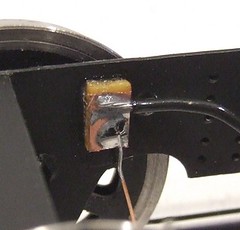I've always had a problem with fitting model locomotive pickups. Normally these are attached to a PCB strip fitted across the chassis. Phosphor bronze wire is my favoured medium - it's nice an flexible so seems to stay in contact with the back of the wheel better than any other metal.
Getting the tension right has always been a fiddle. I tend to settle for soldering the wire in place and then tweaking it around with small pliers to get it in position. This might work but doesn't seem like proper engineering to me.
On the coal tank I've been able to do things a little better than I have with previous attempts. There is enough space in the chassis to give each pickup its own bit of PCB. That makes things easier as soldering a wire in place doesn't dislodge other wires. It also keeps the bronze wires out of danger under the chassis. This might sound daft until you have heard someone describe the results of an O gauge locomotive running over a slug on his garden railway !
The PCB scraps, cut from OO sleeper strip[, were glued in place with superglue. A wire joined them together and on to the motor. Finally the pickup wire was pre-bent and soldered on. There was still some tweaking required but it's not as bad as previous efforts.
Incidentally, the chassis is supplied with holes in place for plunger pickups. I have tried these and when they work they are great. The downside is that any maintenance requires the removal of the locomotive driving wheels as access into the plunger is from the front. So a sticky spring, not an uncommon complaint, requires major work to fix. I suspect you'd look at this and decide to bodge it with a bit of wire making a scraper !

No comments:
Post a Comment